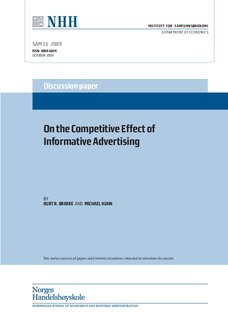| dc.contributor.author | Brekke, Kurt Richard | |
| dc.contributor.author | Kuhn, Michael | |
| dc.date.accessioned | 2009-12-02T12:19:06Z | |
| dc.date.available | 2009-12-02T12:19:06Z | |
| dc.date.issued | 2009-10 | |
| dc.identifier.issn | 0804-6824 | |
| dc.identifier.uri | http://hdl.handle.net/11250/163214 | |
| dc.description.abstract | This paper analyses the competitive effects of informative advertising. The seminal work by Grossman and Shapiro (1984) show that
informative advertising results in lower prices and that firms may benefit from advertising restrictions. A crucial assumption in their model
is that captive (partially informed) consumers are not price responsive. Replicating their model in a Hotelling duopoly version, we show
that results are in fact reversed if we allow for captive consumers to
respond to prices. We then use general demand functions and derive exact conditions for the competitive effect to prevail. A main result is that the procompetitive effect depends on the nature of competition
and the relative price elasticities of the monopoly and the competitive demand segments. | en |
| dc.language.iso | eng | en |
| dc.publisher | Norwegian School of Economics and Business Administration. Department of Economics | en |
| dc.relation.ispartofseries | Discussion paper | en |
| dc.relation.ispartofseries | 2009:16 | en |
| dc.subject | informative advertising | en |
| dc.subject | price competition | en |
| dc.subject | product differentiation | en |
| dc.title | On the competitive effect of informative advertising | en |
| dc.type | Working paper | en |
| dc.subject.nsi | VDP::Samfunnsvitenskap: 200::Økonomi: 210::Samfunnsøkonomi: 212 | en |
